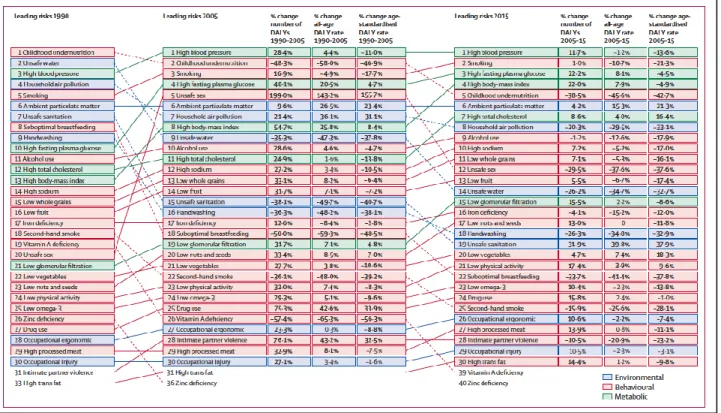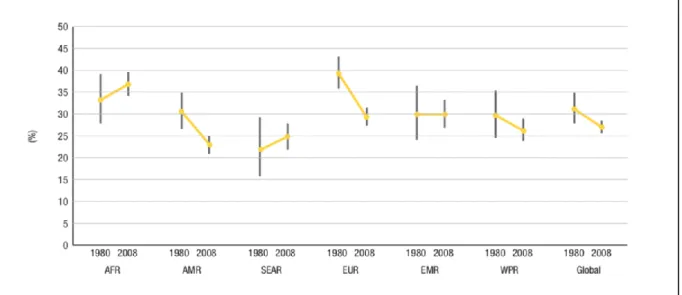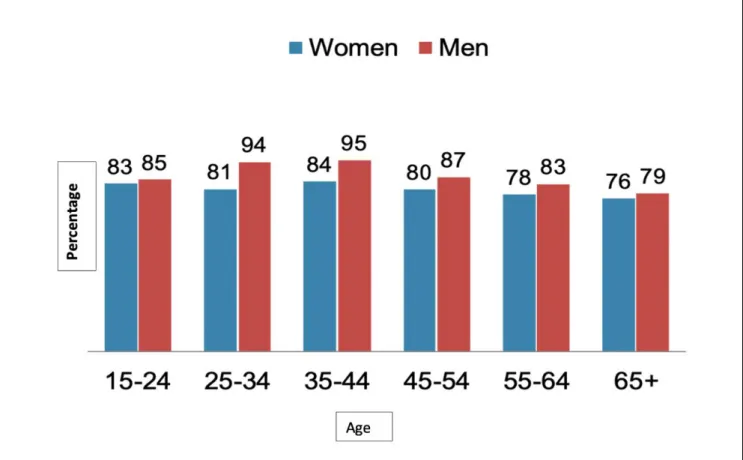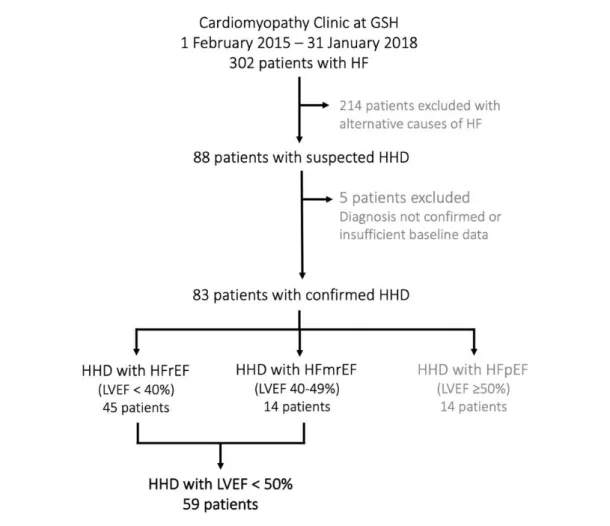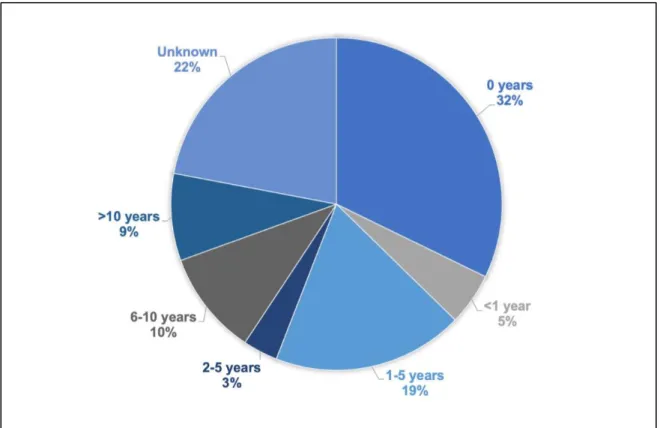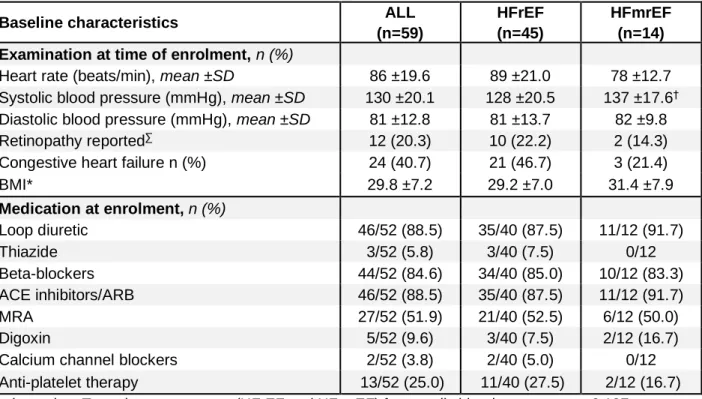The thesis should only be used for private study or non-commercial research purposes. The thesis should only be used for private study or non-commercial research purposes.
Introduction and Literature Review
- Introduction
- Definition and Classification of Heart failure
- Epidemiology and definitions of hypertension
- Global prevalence of hypertension
- Prevalence of hypertension in Sub-Saharan Africa
- Definition of hypertension and blood pressure targets
- Hypertensive heart disease
- Definitions of hypertensive heart disease
- Pathophysiology of HHD
- Clinical features of HHD
- Diagnostic investigations to evaluate HHD
- Prognosis of HHD
Heart failure with reduced ejection fraction (HFrEF), heart failure with mid-range ejection fraction (HFmrEF) and heart failure with preserved ejection fraction (HFpEF). Unlike most high-income countries, Africa has shown an exponential increase in the prevalence of hypertension compared to high-income countries (Figure In the last 10 years, the increase in the prevalence of hypertension in SSA is greater than in every other continent Hypertensive retinopathy is seen in association with high blood pressure and is one of the markers of hypertension.
While limited progress has been made in defining the syndrome, the current consensus is that the following features may be present in HHD; left ventricular hypertrophy, systolic and/or diastolic dysfunction and/or clinical heart failure.25 However, there is growing concern that the current definition of HHD fails to encompass the full spectrum of the various clinical presentations of this condition and fails to adequately guidance in diagnosing HHD in the setting of systolic dysfunction. Differentiating between the types of LVH has prognostic implications.41 Sustained elevated left ventricular stress can result in LVH, left ventricular diastolic and/or systolic dysfunction, arrhythmias such as atrial fibrillation, and finally heart failure.25 LVH is one of the most important markers of HHD is associated with increased morbidity and a two-fold increase in mortality in hypertensive cohorts.42,43,44 In addition, regression of LVH has been associated with a reduction in cardiovascular morbidity and mortality.45. Increased peripheral vascular resistance and cardiac remodeling result in left ventricular dysfunction, including left ventricular relaxation abnormalities and decreased ejection fraction.35 Concentric LVH with left ventricular relaxation abnormalities can lead to heart failure.
LVH is often associated with ST depression and T wave inversion in the lateral leads such as V5 and V6. LA enlargement may precede the development of LVH and this may be used as a marker for premature development of HHD.40 The LIFE study showed that LA enlargement corresponds to the severity of LV diastolic dysfunction and is strongly associated with LVH and impaired left ventricular diastolic function.54,57 LA enlargement is unable to remodel as rapidly as LVH with treatment and is an independent risk for atrial fibrillation, cerebrovascular accidents, heart failure, and cardiovascular events. Approximately 50% of hypertensive patients have LGE, which is associated with diastolic dysfunction.60,66 Limitations to using CMR in African settings are cost and limited availability and expertise to evaluate CMRs with accuracy.65,67.
Furthermore, the current definition of HHD fails to provide sufficient detail in diagnosing HHD in the setting of systolic dysfunction, where blood pressure may be within the “normal range” as a result of reduced cardiac output. Furthermore, improved definitions of HHD in the context of HFrEF may promote earlier detection of HHD with prompt initiation of treatment that could potentially decrease cardiovascular risk of morbidity and mortality.22.
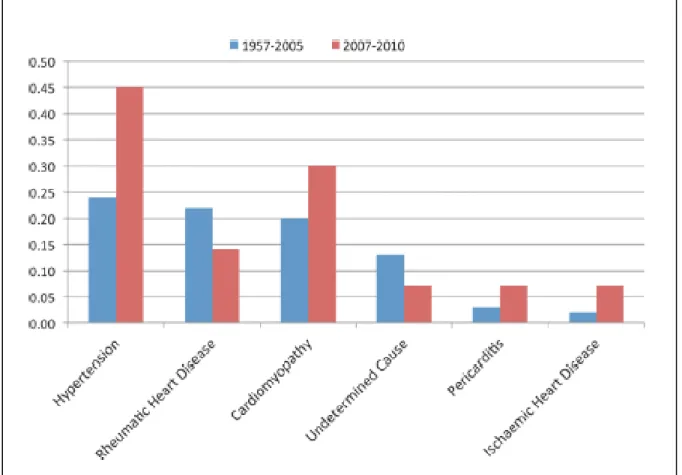
Methods
- Aims and objectives
- Study design
- Study population and patient eligibility
- Primary and secondary endpoints
- Data collection
- Statistical Analysis
- Ethics and safety
- Financing and insurance
All patients referred to the Cardiomyopathy Clinic at GSH with a diagnosis of HFrEF or HFmrEF secondary to HHD were eligible for inclusion. The screening registry for the African Cardiomyopathy and Myocarditis Registry Program (IMHOTEP – HREC 766/2014) started in February 2015 at Groote Schuur Hospital was used to identify patients seen in the cardiomyopathy clinic who were excluded from IMHOTEP with a diagnosis of HHD. Data were obtained from the medical file of the Groote Schuur Hospital and/or the buff file of the Cardiac Clinic.
The Wilcoxon sum ranking (2 samples) and Kruskal-Wallace (more than 2 samples) were used to determine the differences between non-normal. Univariate and multivariate logistic regression analysis was used to examine predictors for recovery of left ventricular function. The respect and confidentiality of all patient data was maintained and clinical information was not distributed or disclosed to the public.
All contact with patients was carried out by the research nurse or the clinician working in the clinic. These staff members are known to patients as they have been working at the clinic for several years. No funding or insurance was needed for this project as this study primarily involved collection of data from hospital records of patients seen at the Cardiomyopathy Clinic.
Results
- Recruitement
- Baseline characteristics
- Baseline investigations
- Follow-up
- Outcomes
At the end of the study period, 6 patients had died, 1 patient underwent cardiac transplantation, 14 patients remained on follow-up at the cardiomyopathy clinic, 22 patients were discharged during the study period for follow-up at primary care facilities, and 16 patients had movement follow-up in the clinic defaulted. Unable to contact patient, but no record of death (or clinic/hospital visits) in the provincial healthcare system database, Clinicom, at the end of the follow-up period. Note that all patients lost to follow-up had NYHA Class I and/or LVEF > 40% at their last assessment, with the exception of one patient (NYHA Class II, LVEF 29%).
Importantly, the vast majority of patients discharged from tertiary care or lost to follow-up were well (i.e., NYHA Class I and/or partial or full recovery of LVEF) at their last clinic visit. Therefore, those being followed up likely represent the more severe end of the disease spectrum. Follow-up showed marked improvement in functional class, with an increasing number of patients reporting NYHA Class I exercise tolerance (baseline, 29.3%, F1, 52.8%; F2, 62.2%), and a corresponding decrease in the percentage of patients reporting heart failure symptoms at follow-up visits (Figure 3.4 [A] and [B]). There was a small increase in the number of patients prescribed calcium channel blockers, as well as an increase in the mean dose prescribed at follow-up.
ACEi, angiotensin converting enzyme inhibitor; ARB, angiotensin receptor blocker; CCB, calcium channel blocker; F1, follow-up 1; F2, follow-up 2; MRA, mineralocorticoid antagonist. At the first follow-up, 28 patients received an echocardiogram, and 27 patients at the second follow-up. Left atrial and ventricular dimensions improved during the follow-up period, however, wall thickness remained relatively unchanged at follow-up.
F1, follow-up 1; F2, follow-up 2; IVS, interventricular septum; LA, left atrium; LV, left ventricular; LVEF, left ventricular ejection fraction; LVFS, left ventricular fraction shortening; LVPW, left ventricular posterior wall; TAPSE, tricuspid annular plane systolic excursion. Vivid suspicion; unable to contact patient, but no record of death (or clinic/hospital visits) in the provincial health system database, Clinicom, at the end of follow-up period.

Discussion and Conclusion
DIscussion
Pseudonormal readings in the context of HFrEF can be attributed to decreased cardiac output and the effects of therapy, including hypovolemia resulting from the use of loop of Henle diuretics and vasodilation.73 It should be noted that there may be differences in blood pressure readings based on the presentation of heart failure. . It has been shown that patients with acute decompensated chronic heart failure are usually able to maintain blood pressure based on compensatory mechanisms. New-onset acute heart failure does not induce adequate feedback mechanisms to maintain blood pressure.74 In our study, mean systolic blood pressure at baseline presentation with heart failure was only slightly elevated and ranged from 88 to 172 mmHg.
There are no clear guidelines on blood pressure goals for patients with HHD and heart failure.9 Optimization of therapy in HHD with HFrEF or HFmrEF is currently based on general guidelines for heart failure, and is not specifically tailored to blood pressure goals. Routine evaluation of noncardiac TOD should be performed in all patients with heart failure secondary to HHD, regardless of blood pressure measurements. The urine protein:creatinine ratio may also be helpful in distinguishing between hypertensive kidney disease (TOD), or primary chronic kidney disease, and cardiorenal syndrome in patients with HHD and heart failure.
The proportion of patients on optimal medication doses for heart failure did increase significantly over the follow-up period, but 24% and 37% of patients were still on suboptimal doses of ACE inhibitors and beta-blockers at the second follow-up (13.2 [IQR months) . Despite this, the death or transplant rate was low for a heart failure cohort and a significant number of patients had partial or complete recovery of their LVEF. Studies have shown that ACE-I and beta blockers improve left ventricular volume, hypertrophy and LVEF.77-79 Reverse remodeling, specifically regression of LVH and improvement of left ventricular dimensions and LVEF, has a proven positive outcome on mortality,80 thus, optimization of heart failure therapy. likely to improve outcomes and recovery rates even further.
Limitations
Conclusion
Recent advances in the epidemiology, pathogenesis and prognosis of acute heart failure and cardiomyopathy in Africa. Medication access, self-care behavior and knowledge about heart failure in urban South Africa: the Heart of Soweto Study. A predominance of hypertensive heart failure in the Abuja Heart Study cohort of urban Nigerians: a prospective clinical registry of 1515 de novo cases.
Clinical and sociodemographic aspects of patients with congestive heart failure at Kenyatta National Hospital, Nairobi. Hypertensive heart failure: a review of clinical status and meta-analyses of prognostic value of echocardiography and antihypertensive medication. Factors associated with poor prognosis among patients admitted with heart failure in a Nigerian tertiary medical center: a cross-sectional study.
Left ventricular remodeling with carvedilol in patients with congestive heart failure due to ischemic heart disease. Antiremodeling effects on the left ventricle during beta-blockade with metoprolol in the treatment of chronic heart failure. Heart failure in Africa, Asia, the Middle East and South America: the INTER-CHF study.
